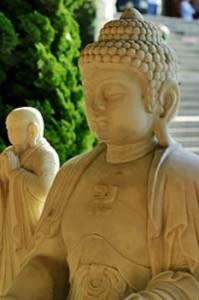Buddhism was first founded in India around 500 B.C. by Buddha. It is the dominant religious force in most of Asia (India, China, Japan, Korea, Vietnam, and Tibet). Today, there are about 300 million followers. The Buddhists faith rests in Buddha, his teachings (dharma), and the religious community that was founded (sangha).
 Buddha’s real name is Siddartha Gautama. Siddartha means “every wish fulfilled.” He was born in 563 B.C. in the small republic of Sakka, Southern Nepal. He was born to a ruler and later tradition saw him as the son of a king. His father’s name was King Suddhodana, and his mother’s name was Queen Maya. One week after Gautama was born, his mother died. It was said that he enjoyed life and was given the best possible education. He was showered with the luxuries of living. Gautama became overwhelmed with the conviction that his life was filled with suffering and unhappiness; therefore, he began to take interest in religious and philosophical thoughts. There were two things that may have caused his spiritual tendencies. One may have been the loss of his mother at birth and the other may have been the position of the weak Sakya kingdom which was about to be taken over by its powerful neighboring enemies. Gautama married a beautiful princess named Yasodhara and had a son named Rahula. He fulfilled his duty by bringing an heir into the world. While on his way to a park, he saw a saffron robed Samana with a shaven head and a calm demeanor. That sight inspired him to adopt that kind of life-style. On his twenty ninth birthday, his conviction led to the abandonment of his wife and son to seek religious enlightenment as a monk. That time was known as the Great Renunciation, because in old Japanese culture leaving their wife or getting a divorce was considered taboo.
Buddha’s real name is Siddartha Gautama. Siddartha means “every wish fulfilled.” He was born in 563 B.C. in the small republic of Sakka, Southern Nepal. He was born to a ruler and later tradition saw him as the son of a king. His father’s name was King Suddhodana, and his mother’s name was Queen Maya. One week after Gautama was born, his mother died. It was said that he enjoyed life and was given the best possible education. He was showered with the luxuries of living. Gautama became overwhelmed with the conviction that his life was filled with suffering and unhappiness; therefore, he began to take interest in religious and philosophical thoughts. There were two things that may have caused his spiritual tendencies. One may have been the loss of his mother at birth and the other may have been the position of the weak Sakya kingdom which was about to be taken over by its powerful neighboring enemies. Gautama married a beautiful princess named Yasodhara and had a son named Rahula. He fulfilled his duty by bringing an heir into the world. While on his way to a park, he saw a saffron robed Samana with a shaven head and a calm demeanor. That sight inspired him to adopt that kind of life-style. On his twenty ninth birthday, his conviction led to the abandonment of his wife and son to seek religious enlightenment as a monk. That time was known as the Great Renunciation, because in old Japanese culture leaving their wife or getting a divorce was considered taboo.
The choice of dedicating himself to the world rather than his family may be the most significant sacrifice he ever made. His renunciation of family life stands as a symbolic precedent for the monastic life of Buddhist monks and nuns. He joined the spiritual teachers of his time, mastered their disciplines, and relentlessly practiced asceticism. He felt, however, that none of these efforts could–nor would–open the path to enlightenment. Six years later, after his body was exhausted, he realized that asceticism was meaningless. He was free after renouncing both his family life and the ascetic practices. He traveled to Buddhagaya and sat under a Bodhi tree. With the sharpness of insight accessible only in the middle way of meditation, he penetrated into the true nature of things. He discovered why people were suffering and also found a way of escaping it. The people from then on called him “Buddha,” which means the Enlightened One.
After becoming known as Buddha, he returned to his family, taught them and took his son under him as a monk. Gautama sought out teachers from what he could learn spiritual techniques and master their teachings. He then inquired after the meditation state on which they were based on. Buddha gave his first sermon at Benares to five ascetic monks who had practiced with him earlier. That is called the turning wheel of Dharma. Following that initial conversation, he traveled throughout northern India for 45 years teaching the rich and the poor, the powerful and the lowly, the beggars and the sages with deep compassion for all and with tempered wisdom and cool logic. He passed away peacefully at the age of 80 in Kusinagara. One interesting thing in Gautama’s life is that he was born under a tree, he achieved enlightenment under the Bodhi (“tree of wisdom”) tree, and gave his first sermon in an animal park, and he died between two trees.